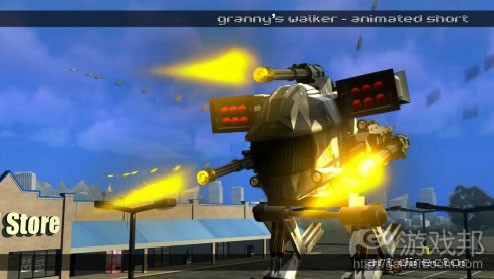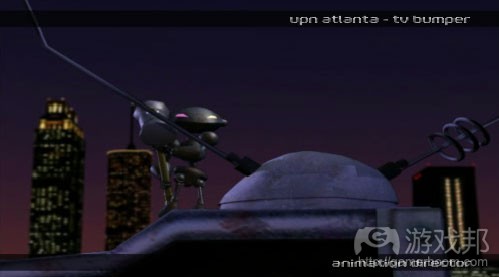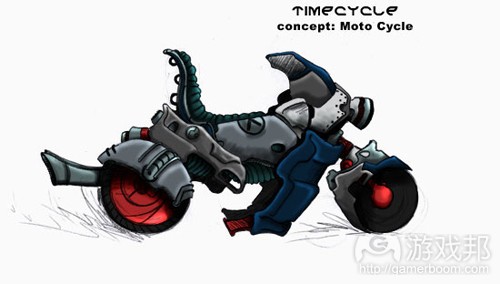游戏动画师找到位置的四个重要步骤
作者:Rich Ponte
登上游戏行业的船不等于你就成功了,而是登船之后如何守住行业中的一席之地。有抱负的游戏开发者通常可以凭借才能和经验获得一张船票,但走错小小的一步也可能让你登不上船而被迫留在岸边疑惑发生什么事了。
正在找游戏动画工作并期望保住工作的人,不妨看看下面的建议。
第1步:获得船票
无论是在动画行业还是游戏行业,有作品才有面试机会。当然,一封格式正确、语法无误的简历是有帮助的,如果业内有朋友那就更好了。但是,你的作品质量才是获得船票的关键。
所谓作品集,就是将你最好的作品组织成集,用于展示。大多数情况下,作品集是做成演示样本或网站。在过去,可能还要包括一本平装册,现在有时候也需要。但无论要求是什么,最终要求是一样的:高质量的作品。如果你是一个全面发展的美工,那也是有帮助的。虽然这一条不是必要的,但我更乐意雇用一位也会画画的优秀模型师,而不是一名没其他特长的优秀模型师。
如果你的作品质量没问题了,接下来要做的就是简单。以有创意又直接的方式展示你的作品,不要让看的人费脑筋琢磨你到底要做什么。如果你想做一个作品库涵盖过去的作品,那它在网站上的地位也只能次于“演示样本”。说到底,面试官要看的第一件也是最重要的东西就是你的演示样本。如果能在作品中添加一些有深度的解释性文本,也是有益的;不过,这仍然不比作品本身重要,因为只有在面试官想多了解你的技术时,他们才会阅读那些文本。
如何将演示样本与作品集网站结合起来?你需要的一项重要技能就是自审:即评判你的作品是好是坏的能力。但愿在你求职时,你的所有作品都是好的。但在作品集中,总是有些作品会比其他作品好。你要带着批判的眼光、客观地审视你的作品,这是非常重要的,只有这样你才能挑出最优秀的作品。不要带着自满的情绪看待你的作品,而要把那件作品当成别人的。只有这样,你才能排除个人私心、公正地选择你的作品。
即使面试官从来不说,他们对你的网站的看法和感觉也像你的作品一样重要。你要这么想:如果你的作品与别人的一样惊艳,那么你们的技术水平是相当的。但是如果你的作品集包在一个油乎乎的纸袋里,而你的竞争对手的作品装在一个整洁的塑料文件夹内,那么你可以走了,那份工作不会是你的。你的展示表现会暴露你的审美水平和专业信心。不考虑技术水平,你能看出什么部分做得好什么部分做得不好吗?你真的是能融入公司人才库的创意人才吗?当面试官看到你的作品很好,包装却很差时,这些问题就会在他们的脑海里浮现了。
总而言之,在面试前你要准备的是:
-高质量的作品集
-学有所长,全面发展
-由最佳作品组成的演示样本
-设计一个好网站(不是博客)来展示你的作品
-格式规范、语法正确的简历
-良好的美感,批判的眼光
第2步:登船
现在你得到面试机会了,你得准备面试行头了。问问对方要穿什么总没害处。有害的是,面试时着装不正式或太正式。大多数HR都乐意告诉你他们期望你怎么着装。你可能会认为在创意行业里,穿合宜的衣服去面试不是太要紧。但是,事实却并非如此。你要想到的是,进入面试环节的人在技能水平上都是接近的。这时候就是人靠衣装了。你是穿西装打领带,还是穿牛仔裤和运动鞋?唯一的办法是问,如果你不问,别人会觉得你甚至连你求职的公司是干什么的都不知道。这确实不是什么大事,但小事也可能成为决定因素。所以,你一定要与面试你的人谈谈,问问题,然后有备而来。
面试大概是找工作中最有压力最可怕的部分了。面试是决定成败的时刻,你可能高兴着离开,也可能疑惑着离开。你很可能没有获得工作,但有些时候你明明失败了,在离开时却自我感觉面试得不错。你觉得你说了所有该说的话,正确回答了所有问题,作品集很棒,所有人好像都心情舒畅、兴趣盎然。或者,你会怀疑自己是否说了不该说的话,做了不该做的事,是不是太笨拙或太烦躁,是否表现得够聪明或太浮夸。面试官的真实想法是什么?
如果你观察得够仔细,你可能会注意到一些迹象暗示了事态发展不妙:
他们并不需要你:
如果面试官急于结束面试,或看起来像有其他事要忙,无论他们是对你不感兴趣,还是不急着招聘员工。
他们已经决定录用他人:
如果面试官看起来好像有抗拒感或不热情,你的处境可能比较不走运了,因为这场面试不会录用任何人。
你可能不能要这份工作:
面试官可能看起来咄咄逼人,对你的作品吹毛求疵,对你的想进公司的理由挑三拣四。在这种情况上,员工对自己的工作是不满意的。有可能是因为今天运气不好,也可能是这份工作就是你不该要的。
但是,如果你吸引了他们的目光,觉得他们确实是有兴趣的,那么你大概可以深呼吸一下——至少你是有机会了。只要你的作品和表现都不差,你和其他人的机会就是均等的。从这点看,你能不能得到这份工作,还得看其他候选人有没有出错,或者你是不是被面试的人当中最出色的。
第三步:找座位
面试后的几天,几周或几个月后,你接到电话让你去上班。第一道坎容易过,就是你在面试时就想到的或问到的:工资和福利、职位和入职日期。这些都应该先计算好或你在申请职位前就已经有所了解。现在我们假设这些都没问题,你接受了工作,然后我们可以进行下一步了。
第二道坎?保住工作。除非你隐瞒了你的实际能力,是靠小把戏混到工作的,否则你基本上可以相信你不会第一天上班就下岗。此时,你要有信心,怀疑自己等于自毁前程。现在不是怀疑自己的时候。如果你还对自己没有把握,那么丢掉工作就是迟早的事。
对于最有创意的职业,与你身边的同事交流互动是你最重要的技能,也是你在公司里每天都在做的事。所以这第二道坎就是个性特征——不要显露你的缺点。如果你认为你没有缺点,那你就错了。你的缺点可能连你自己都没有想到,但在上班两周后谁都可能露出马脚,如果你不小心踩到地雷了,炸掉的可是你自己的腿。在这里举个很多人都想不到的例子:没人想闻到你的午餐的味道。听起来很傻,但无论如何,在工作环境里,为他人着想是非常重要的。特别是在一个近距相处时间很长的工作环境里。个人卫生是一个值得注意的大问题,原因是:如果你闻起来很香(香水喷太多)或很臭(香水喷太少),同事会很不想靠近你。
现在那两个问题你都解决了。当你面临更加抽象的问题时,你要怎么办?
无论是动画还是游戏设计,截止日期都是最棘手的部分。如果你的任务有明确的交付时间或日期,那就是截止日期。有时候,截止日期是浮动的,但大多时候是固定的。如果你错过或没有达到目标,你可能会收到这样的信号:领导不高兴,后果很严重。你会马上被炒鱿鱼吗?可能不会,除非你造成重大损失。虽然一次失误不会让你丢掉工作,但量变导致质变,失误的累积肯定会让领导或上司质疑你的能力。被质疑是大多数人丢掉工作的原因,因为如果你的能力或水平遭到质疑,那么公司就没理由留下你了。不幸的是,在游戏或动画领域,你必须不断通过高品质、稳定的作品来体现你的价值。如果你开始错过或赶不上截止日期,那么你在船上可能就找不到座位了。
如果赶截止日期的问题也解决,那还有什么要担心的吗?有,你必须合作。是的,那个词被用滥了,大多数人认为你不应该在简历中提到它(正确!),但是合作的能力是很有价值的,有时候甚至超过你自己单独工作的能力。你可能是工作室里最杰出的美工,但如果没有人愿意与你合作,因为你的坏习惯或坏脾气,那么你差不多可以交辞职信了。这一点也适用于接受批评。没有领导会为了你的玻璃心而不敢批评你。你要做的是听取指示并提交达标的成果。不懂合作最终也会导致他人的质疑;如果这种质疑出于对你的作品,那么你要保住现在的位置就更加困难了。
这意味着你应该每天都担心这些事吗?不是,当然不是。你要有意识地记住这些事,这样如果你不小心出错了,你就能及时调整并改正那些坏习惯。你不只是在项目进行过程中不犯毛病,而且要保持到最终改掉坏习惯。最后要提醒你的是,如果你犯了这些禁忌,你不要以为没人说什么就等于没人注意到。可能直到下一个项目开始,你才意识到问题——分配给你的工作变少了或你被调到其他部门或甚至根本没份参与新项目。
第四步:保住座位
这时候,你已经通过优秀的作品集得到工作了。你的工作职业道德和专业水平使你能够应对日常工作,别人可以指望你了。一切顺利,无忧无虑。
当然还有要担心的事,不过别着急。还是那句话,你必须意识到你所处的行业的期待。所以不要以为你上了船就没有什么能拦着你了。总有其他想登船的人,总有比你年轻比你激情的人,总有比你技术更先进的人。所以你必须不断更新你的作品集和技能。让你得到现在这份工作的作品和技能不会永远帮你保住工作,如果你不乐意学习和尝试新事物,你很快就会失去现在的位置。
最后也是最重要的是,享受工作的每一分钟,对工作有热情,干一行爱一行。因为如果你做不到,你的工作就永远不会成为你生活的积极部分,你的事业就永远达不到顶峰。
额外的一步:
以下是一些从事动画和电子游戏的人的心声:
“动画师要有多方面的素质。你可以成为了不起的动画师,但如果你赶不上截止日期,如果你不懂团队合作,如果你不懂听从指示,你最终会遇上麻烦的。” ——Gabriel Portnorf(DreamWorks Animation的CG总监)
“专业,交流。”—-Sketch MacQuinor(Radical Axis的Flash动画总监)
“并非所有游戏工作室都是一样的。你应该知道这家工作室做什么:FPS还是RPG,动作还是冒险,等等。看看这家工作室以前的作品。它做过主机游戏吗?掌机?手机?根据这些信息准备你的简历和面试。”——Adam Olshan(Vicarious Visions的高级动画师)
“进入游戏行业的最好办法是挑一款你最喜欢的游戏,然后给这款游戏设计原创内容,最后把这些内容发给那家制作公司。这个办法对具有可修改内容的游戏更容易。如果行不通,那最靠谱的办法就是先做游戏测试员。当你进入游戏行业,最重要的事就是比任何人都更努力工作。这样一般就能成功了。”——Fairfax McCandlish(Respawn Entertainment的游戏设计师)
“一旦进入游戏行业,在技术上与时俱进和快速适应就是非常重要的事。通常你刚学会一种技术,它就变了,你又要再学习或再研究。专注于你的核心技术,同时不断学习新事物。”——Chris Myers(Neversoft角色动画师)
“性格决定一切……无论你有多聪明多能干,如果你的性格有硬伤,最终谁都不想与你合作——包括你的上司。”——Jason Davies(Pixar)
(本文为游戏邦/gamerboom.com编译,拒绝任何不保留版权的转载,如需转载请联系:游戏邦)
How To Get (And Keep) A Job In Video Game Animation
by Rich Ponte
The trick to succeeding in game development is not only getting in the door, but learning how to stay there once you’ve gotten in. Talent and experience can usually open doors for an aspiring game creator, but some very small missteps can ultimately close those doors again with you standing outside in the cold, unforgiving rain wondering what just happened.
Here are a few tips for those of you looking to find and keep a job in video game animation.
Step 1: Get the door open!
In both animation and video games, it is your portfolio that gets you the interview. Yes, your well formatted and grammatically correct resume helps,and so does having friends in the business. But the quality of your works is paramount in opening the doors to a successful career.
The portfolio is an organized display of your very best work. In most fields, it is organized as a demo reel or website. In the past a flat book may have been included and is sometimes still called for. But in any set of requirements the ultimate need is always the same: High quality work. It helps if you’re a well-rounded artist as well. It isn’t a necessity but I would rather hire a good modeler that also paints then a good modeler that has no other creative skills.
If your work is all quality, keep it simple. Display your work in a creative yet straightforward manner; don’t make the viewer work to see what you’ve done. If you want a larger library of past work, make that secondary to the presentation of the “demo reel”on your website. In the end, the first and most important thing a potential employer should see is your reel. It’s also beneficial to include an in-depth explanation if your work, but that secondary to the reel because employers will only read it if they would like to know more about your creative skills.
Ponte’s animated short Granny’s Walker
An important skill to have with putting together a reel and portfolio website is self-editing: The ability to see if your work is good or bad. Hopefully when you’re applying for a job all of your work is good. But with any portfolio, some work will be better than others. It is important to be able to view your work critically and outside of yourself so you only include your very best pieces. Leave pride out of the equation and look at the work as if it is not your own. Only by doing this will you be able to step outside of your personal feelings, whether they’re good or bad.
Even though they’ll never say so, the look and feel of your website is just as important to potential employers as your work is. Think of it this way: If your work is amazing and so is someone else’s, you’re considered equal in skill. But if your portfolio comes packed up in a greasy paper bag and your competition’s is in a shiny slick plastic clamshell, that job will not be yours. Your presentation of the work you do speaks to your aesthetics and professional pride. Can you see what does and does not look good outside of your skill set? Are you a truly creative person that can add to the company’s talent pool? Those types of questions will arise while looking a good work in a bad package.
Another short animation from Ponte’s demo reel
So to sum it up, here’s what you need to get an interview:
- A Portfolio of quality work.
- A well-rounded creative background, with more than just one skill.
- A demo reel that contains the best work you have done.
- A well designedwebsite — not a blog — to display your reel.
- A resume that’s formatted properly and grammatically correct.
- A good sense of aesthetics and a discerning critical eye.
Step Two: Avoid the back swing!
Now that you got the call for an interview, ask what to wear to the interview. It can never hurt to ask. It can, however, hurt to arrive to your interview over or under dressed. Most human resources staff would be more than happy to give you some advice on how they expect you to dress. You would think that wearing the appropriate clothes to an interview would not be a very important thing in these creative fields, but it is. It goes back to the idea that everyone who is getting interviewed is at the same skill level for the most part. It is the packaging that makes the difference. Do you wear a tie and suit, or maybe jeans and sneakers? The only way to know is to ask, and if you don’t, you will seem like you didn’t know about the company you are trying to work for. It really isn’t a huge thing, but that small difference can be the deciding factor. Make sure to talk to the person setting up the interview, ask questions and come prepared.
Of course the interview is probably the most stressful and nightmare-inducing part of the job hunt. This is the make-it or break moment, the point at which you will either leave happy or leave wondering. You will most likely not leave with the job; in some instances that does happen, but for most you leave with the feeling you did a great job in that interview. You feel you said all the right things, answered all the questions correctly, had a great looking portfolio, everyone seemed happy and interested. Or you will be wondering if you said the right things if you did the right things, if you were to awkward or too fidgety, if you came across knowledgeable or maybe too pompous. What the real thoughts of the people that just interviewed you?
If you watch carefully, there are some telltale signs you might notice is things are going poorly:
The sign you’re not really needed:
First, if the interviewers were eager to get the interview over with and seemed like they had something else to do, either they were not interested or you hiring is not high on the priority list.
The sign they’ve decided on someone else:
If the interviewers seemed to be defensive or unenthused, you may have had the unfortunate circumstance of getting an interview that no one felt was wanted or needed.
The sign you might not want the job:
The interviewers might have seemed aggressive and overly critical towards your work and the reason why you would want to work there. This happens in circumstances where the employees are not happy with their jobs. It could just be a bad day or it could be that this is a job you should avoid.
But if you hold their attention and feel they were genuinely interested, then you can probably take a deep breath and know that at the very least you have a chance. That small chance is equal to anyone else as long as your work is as good and your presence was strong. From this point on, until you either get the job or not, it is all about what the other candidates did right or wrong and whether you were the best one who was interviewed.
Step Three: You got the ball, don’t drop it.
A few days, weeks or months after the interview you get the call, and the job is yours if you want it. The first hurdle is hopefully an easy one, one that you had the foresight to think about and maybe ask about during the interview: Pay and benefits, relocation and start date. All of those should either be worked out already or you had prior knowledge of them before you even applied for the job. So lets say that everything is good and you accept the job, time for the next big step.
The second hurdle? Keeping the job. You can almost bank on the fact that unless you lied about your skills and somehow tricked your way into the job, your first day will not be your last. Be confident in what got you to this point, because self-doubt can be a real job killer. Don’t start second guessing yourself now. If you do, you could be heading down the road to losing that job.
Your own demo reel might include anything from concept art to finished pieces
As with most creative positions, the people around your and your interaction with them is a very important key skill that factors into every day you spend in the workplace. So the second hurdle is personality traits — keep your bad ones in check. If you think you don’t have any, you are wrong. It can the something that you have never thought of, but at three in the morning after two weeks of crunch anyone can get a little crabby, and if you are the one to step on the landmine then it is your leg that is gone. Here is an example that not many people think about: no one wants to smell your lunch. It seems silly but in all reality in a workplace being considerate of others is very important. Especially in a workplace that has long hours in close proximity. Personal hygiene is a huge area to be observant of because of two important reasons, if you smell either overly good (too much perfume) or bad (not showering enough) it will be hard for coworkers to be around you.
Now those two examples are easily in your control. But what happens when you have to deal with something a bit more abstract?
Deadlines are the hardest part of either animation or game design. If you are given tasks that are due at a specific time or day, that is a deadline. Sometimes they are flexible, but in all likelihood few ever are. By missing a goal and not meeting it you at that moment will probably receive some feedback from your lead or supervisor that they are not happy. Will you lose your job right then? Probably not, unless it was a very big deal, but it is not the single instance that kills your opportunity, it is the sum of all of those missteps that lead to doubt. Doubt is the cause of most lost opportunities, because if your lead doubts your ability or skills then there is no reason he will keep you on the project. Unfortunately in the field of video games or feature animation you need to constantly be proving your value through the quality and consistency of your work. If you begin to misstep and drop that ball by deadlines that door can ultimately click closed with you outside.
So that is it right? Nothing else to worry about?Unfortunately, no.You need to be a team player. Yes, that is an overused word that most people say you should never use on a resume (which is right!), but the ability to be one is valuable. Being able to work well with others is sometimes more valuable than your ability to do the work. You can be the most amazing artist in the studio, but if no one wants to work with you because of a bad habit or personality quirk, you can almost sign your own walking papers. This also goes into taking critiques well. No lead or supervisor wants to have to walk on eggshells because any form of criticism constructive or otherwise will lead to a breakdown or anger on your part. Being able to listen to instruction and return the instruction with the correctly done product is also part of this. And again it all really comes down to doubt; if that feeling of doubt arises from any part of your work, it can ultimately make it harder for you to hold on to your current position.
Now does this mean you should worry about these things every day? No, of course not. But be consciously aware of them so if you happen to misstep you can adjust and fix those bad habits or quirks. It’s about making it through that project still carrying the ball, not dropping it. One last little tip though — if you’ve made those missteps and no one has said anything and you think no one has noticed, they have. You will most likely not know it until the next project when you may be given less to do or you’re moved to a different department or in some instances not picked up for the next project.
Step Four: I’m on a boat.
At this point you have worked hard got a good portfolio that led to an interview that gained you employment. Your work ethic and professionalism gets you complements on a daily basis and people can count on you. Everything is good and there is nothing to worry about.
Well of course there is, but don’t worry, per se. Again, you need to be aware of the expectations of the field you are in. So you are on the boat and nothing can stop you now. But other people want on that boat and they will be younger and hungrier, there will always be someone there with new more current skills and techniques. So it is your job to always be updating your portfolio and your skills. The one that got you to where you are won’t last forever, and you do not want to lose what you have because of an unwillingness to learn and try new things.
Last and most importantly, enjoy every minute of the job, have a passion for the work, love what you do, because if you don’t, the work will never be a positive part of your life and your career will never get to this point.
Extra Step: Listen to the trees in the forest.
Below are some quotes from people in animation and video games on getting and keeping that dream job you are striving to obtain.
“It’s a combination of a bunch of things. You can be an incredible animator, but if you don’t hit deadlines, if you don’t work well with a team, and if you don’t work well with supervision you will eventually have trouble.”
- Gabriel Portnorf – CG Supervisor at DreamWorks Animation
“Stay professional and keep your contacts.”
- Sketch MacQuinor – Lead Flash Animator at Radical Axis
“Not all video game studios are the same. You should know what the studio creates: First person shooters, role playing games, action/adventure games, etc. Take a look at what the studio has created in the past. Has the studio shipped titles for console? Handheld? Mobile? Tailor your initial contact with this in mind. ”
- Adam Olshan – Senior Animator at Vicarious Visions
“The best way to get into the game industry as a designer is to pick your favorite game and then find a way to design your own content for it and submit it to the company that made it. This is easier with games that have modifiable content. If that doesn’t work, the usual fallback is to get a job as a game tester. Once you have a game job, the most important thing is to work harder than anybody else. That usually works”
- Fairfax McCandlish – Game Designer At Respawn Entertainment
“Once in the video game field it is important to keep up to date with current technologies and be able to adapt quickly. Often as soon as you are familiar with one aspect of a pipeline or technology, it changes and you are learning or developing again. Focus on improving your core art skills while continually developing to new workflows.”
- Chris Myers – Character Animator at Neversoft
“Character is everything… no matter how smart or talented you are, if you’re a lying duplicitous prick eventually no one will want to work with you…. including supervisors.”
- Jason Davies – Pixar (source:gamecareerguide)
上一篇:举例分析电子游戏的主题颜色类型












































